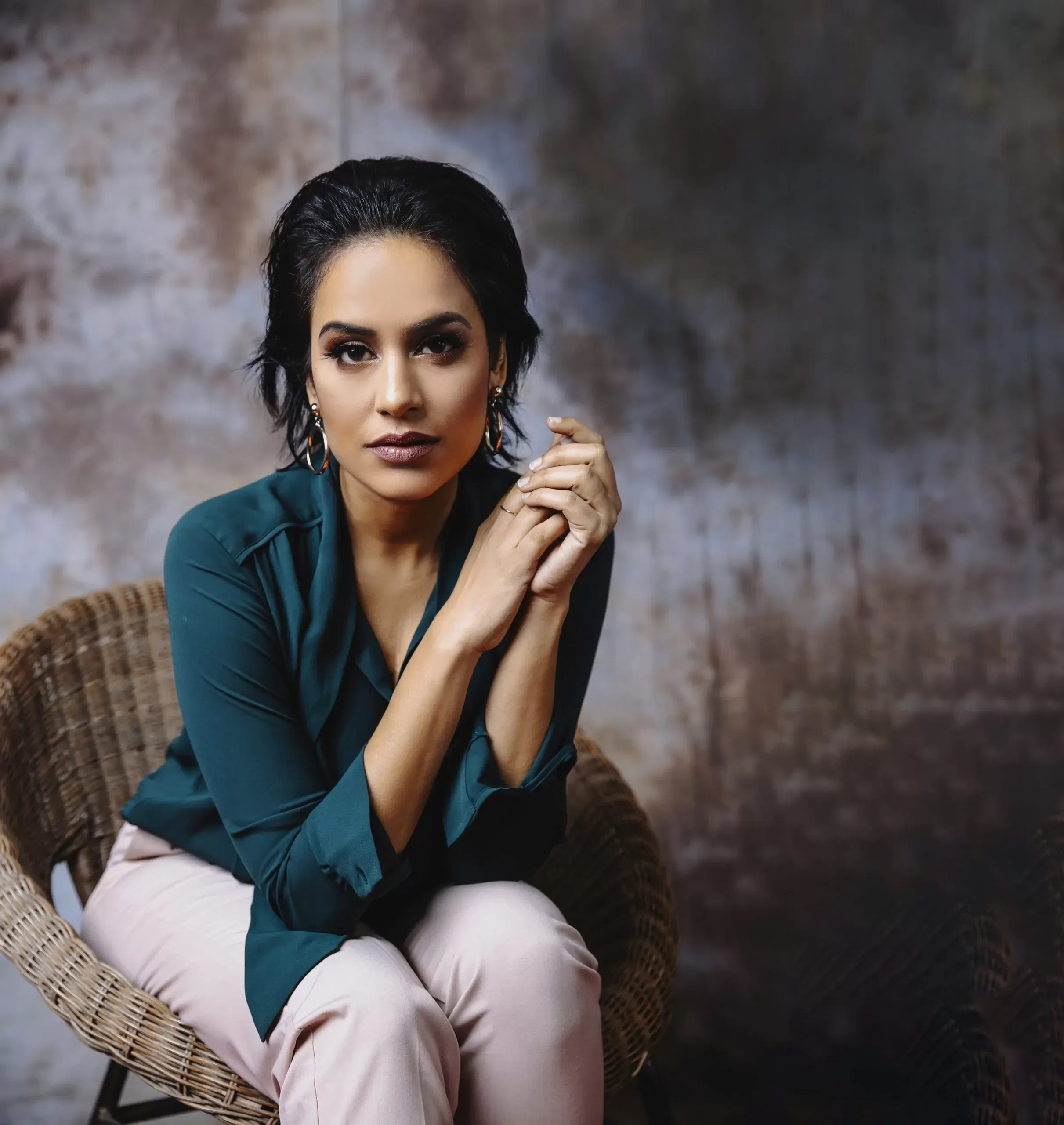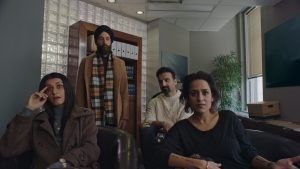- Thursday, April 25, 2024

By: ASJAD NAZIR
HOW AGAM DARSHI DID IT ALL WITH HER FILM DONKEYHEAD
ONE of the best reviewed and most unique film releases of 2022 featuring south Asian protagonists has been Donkeyhead.
The Canadian comedy-drama on Netflix has surprised audiences globally with unapologetic storytelling that mixes up humour and deep emotions.
The heartbeat of the magnificent movie is writer, director, and lead star Agam Darshi. She has delivered a standout performance as a woman who slowly starts to unravel when her terminally ill father goes into a coma and more successful siblings return to say their final farewell.
The acclaimed family drama has started an exciting new chapter for a versatile talent who has appeared in Hollywood projects across the last 18 years.
Eastern Eye caught up with the 34-year-old writer, director, and actress to discuss her film Donkeyhead. She also spoke about representation and immense power audiences have through their choices.
What first connected you to creativity?
I’ve always been creative and don’t remember being any other way since childhood. My mom used to say I was a rambunctious child and always running around a lot. The only way she could get me to sit still was by giving me crayons and a piece of paper, and then I could sit there for hours just colouring, drawing, and creating. So, that’s always just been one place I was able to focus on and just sort of connect to myself, perhaps.
You have had an interesting acting journey, where you have been one of the few south Asian faces to do diverse Hollywood projects. How do you reflect on it today?
I have been very fortunate and worked incredibly hard to get to where I’m at right now. I’ve been asked a lot what it’s like to be a woman of colour in this industry and not having had a lot of opportunities because of it, or how do you reflect on that. If you see yourself as a minority or that you have a handicap, then that’s how people are going to see you. What I’ve always done is just go out into the world, feeling very much like I belong there. Then people feel like you do as well. So, I think that’s been part of my success as an actor. When I look at all the things I’ve done over the years, it varies quite a bit. I like the fact I’ve been able to play so many different characters in a vast career. It’s a cool feeling.
Your film Donkeyhead is so unique. What led to it?
I started writing it a long time ago, off and on. I personally love indie films about families and coming of age stories, but they never reflected visually who I am and the world I’m from. So, I’ve always wanted to just write something that was about a south Asian family, which felt just as Canadian or just as western as they do. So, that was the seed and it sort of went from there.
What made you want to direct and play the lead role. That is quite an undertaking?
I wrote it for myself to play Mona, partly because even though I’ve had a really wonderful career, I’ve always found that the ceiling I personally hit was never being seen as a lead. I was never number one on the call sheet. When you flip through TV and go through movies, usually there are stories about white people and BIPOC (black, indigenous, (and) people of colour) tend to be the supporting roles, so that’s usually where I found myself. So, I wanted to give myself the opportunity to carry a film. I was looking for a director and trying to find the right producer.
What led you to directing it finally?
As I was trying to find the right director and producer, I realised this is such a personal story that I couldn’t just hand it over to anybody. I had such strong feelings about what it should look and feel like that I needed to direct it myself. Then I had a mentor, Robert Cuffley, who is a very accomplished director and he basically said ‘I’ll help you. I’ll mentor you through this because I think you can do both’. So, once I had him saying that, I felt more confident being able to pitch myself as a director as well.
How did you manage to draw such an amazing performance from yourself, when you are directing the film?
Thank you! I’ve been acting for so long that I feel like the acting part is easy for me. You know, my machine is as good now, as it’s ever been. I feel very confident in my ability to make strong choices and live in a character, and because Mona came from me, I knew her inside and out. I also worked with a great acting coach prior to shooting, going through all the scenes, trying to define who Mona was and what her motivations were, and just really grounding her to myself. So, I felt very prepared being on set and was able to just like snap back and forth pretty effortlessly, which was pretty cool because I wasn’t sure exactly how that was going to go down. But it was a nice surprise.
You get invested in Donkeyhead lead character Mona and want her to do well, but she is doing bad things. Is she a good or bad guy?
(Laughs) I think she’s human. I think we’re all good and all bad. I think in my heart, she’s good. She’s misguided and makes bad choices in life out of fear, but ultimately, she wants what’s best for herself and for the people around her. She just doesn’t know how to do it. There’s a lot of great moments in Donkeyhead.
What is your favourite?
I love the hockey scene between Mona and Parm. That’s one of my favourites. I love the ‘O Canada’ scene because that was just really fun to shoot. I love a lot of the sibling scenes because we just got along so well, and there are such great actors, Sandy (Sidhu), Stephen (Lobo) and Husein (Madhavji). They felt like real siblings to me. It is perhaps the best reviewed film this year featuring south Asian protagonists.

How much does that mean to you?
It’s amazing! I didn’t know how people were going to feel, having this film out there, especially those from the community because it pushes boundaries and there are definitely some moments that people are shocked by. But as a filmmaker you want people to connect with what you put out there and want them to not just enjoy it, but have it resonate as well. And have them think about it days later. So, I’m thrilled by just all the people that have been so supportive and reached out that they have loved the film. It’s been pretty overwhelming.
The film is very unapologetic with some scenes. Would you say that you are fearless?
I don’t know if you can call yourself fearless. I think other people call you that. I have a lot of fears, but I guess it’s just the ability to do it anyway. That’s basically it. Like I was terrified making this film and putting it out there, but at the same time I don’t know any other way. You have to put it out there because you believe in it. I had people tell me, don’t direct and act, don’t show that Parm is gay. There were a lot of opinions about what not to do, because it could fail. At the end of the day, you just have to listen to that inner voice and say I’m going to do it anyways because it feels right. So, I guess that could be considered fearless.
What can we expect next from you?
I have a few different options, which is really nice. Currently, I’m in development for another feature called Tiny Birds With Broken Brains. It feels different than Donkeyhead in some ways and bit more of a drama. But again, it’s about family. I find family fascinating. It’s set in the 1980s to 1990s in a rural town in North America. It’s puts a magnifying glass on, particularly, a mother-daughter relationship. I’m also working in development on a TV series called Meet The Johals.
What can you tell us about that?
It is about an extended family, south Asian family that lives in one house together in Abbotsford BC, which is basically outside of Vancouver. Because real estate prices are so expensive, they all have to live together. It’s a comedy I’m writing with a wonderful writer named Leena Monroe. So, I have a few different projects right now, which are always going to be focused on a diverse perspective and a diverse voice. That’s kind of what I’m interested in.
Creatively, what inspires you?
You know music always does it for me. I think it’s part of my process as a writer, filmmaker, and artist. Like, I just hear a certain song and if it fits into that world, I sometimes put it on repeat because it hits something inside of me. Then it makes it so much easier to write or create from that place. Other creatives always inspire me, like when I watch a movie or read a book that is from an interesting perspective. That always pushes me and sparks something inside of me.
Why should we watch Donkeyhead?
Because it’s a good film and gives another diverse perspective that’s much needed in the world. I think these days there’s something political about choosing what you want to watch and listen to, read, and download. There’s a lot of buzz words like BIPOC, diverse and all of that. But they are buzz words for a reason, where we’re trying to change the world by giving people more perspectives.
Tell us more about that…
When I grew up there was nobody on TV that looked like me. It felt very isolating. Now, we’re seeing many other perspectives and beautiful stories. So, by clicking on that and deciding to watch that over the latest, Transformer film or whatever, it’s a political choice. Like you’re basically telling the powers that be, ‘hey listen I want to see this. It has my vote’. This is what you should be funding, and these types of films should be made. I think people have a lot more power than they realise with their choices.